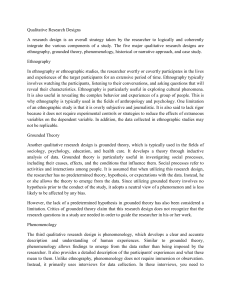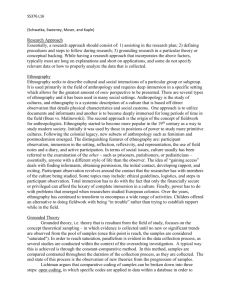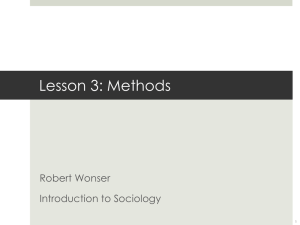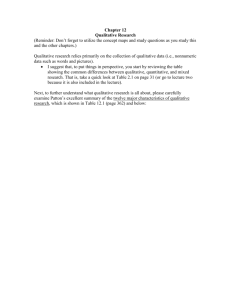The Importance of Qualitative Research in Mixed Methods
advertisement
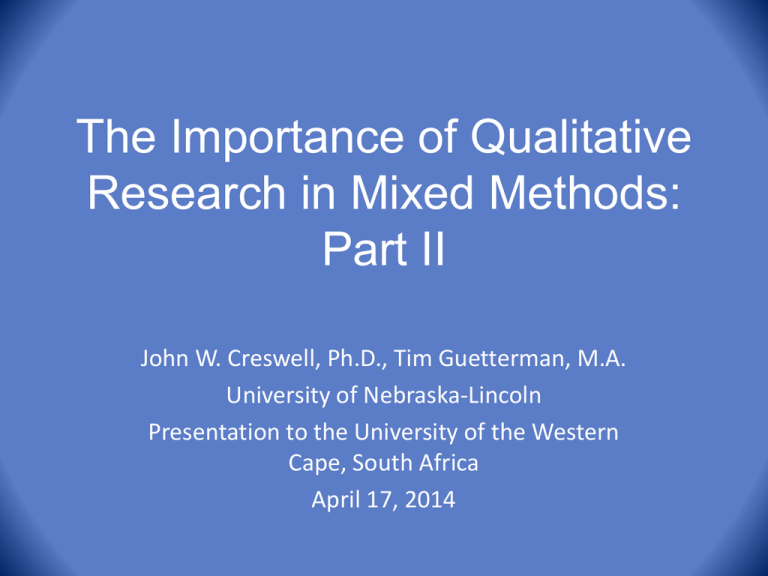
The Importance of Qualitative Research in Mixed Methods: Part II John W. Creswell, Ph.D., Tim Guetterman, M.A. University of Nebraska-Lincoln Presentation to the University of the Western Cape, South Africa April 17, 2014 Topics for this session • Five approaches to qualitative research • Data collection, field issues, ethics • A software program (MAXQDA) Five Approaches to Qualitative Research SAGE book, 2013, 3rd edition, “Qualitative inquiry: Choosing among five approaches” • Why I wrote the book • How I chose the five approaches • Defining characteristics of each of the five approaches Why I wrote the book • • • • • Saw Harry Wolcott’s tree diagram (1992) Saw Reneta Tesch’s flowchart (1990) Saw Jacob’s types in Review of Educational Research (1987) Interested in providing rigorous methods for students Saw that the procedures differed – wanted to make comparisons (hence final chapter) • Recognized that most professors taught out of their own background and training Wolcott’s Tree Choices of Approaches (types) • • • • • Narrative (literature) Phenomenology (psychology) Ethnography (anthropology) Grounded theory (sociology) Case studies (evaluation, political science, law) Illustrative journal articles • Narrative – Chan’s study of a Chinese immigrant student in Canada • Phenomenology – Anderson & Spencer’s study of how persons living with AIDS image their disease • Grounded theory – Harley et al.’s study of physical activity for African-American women • Ethnography – Haenfler’s study of the straight edge punk subculture of the 1980’s • Case study – Asmussen and Creswells gunman incident on a college campus Primary Texts • Narrative – (Clandinin & Connelly; Riessman) • Phenomenology – (Moustakas; van Manen) • Ethnography – (Wolcott; Fetterman) • Grounded theory – (Strauss & Corbin, Charmaz) • Case studies – (Stake, Yin) What is the research intent of your qualitative study? Describing/analyzing a bounded system Individual, program, event, process Case Study Culturesharing group Ethnography Reporting individual experiences Generating a Theory Process, action, or interaction Grounded Theory Individual experiences Collective experiences Phenomenology Autobiography Biography Narrative Research Life story Features of Narrative Studies • Researchers collect stories from individuals • These stories tell individual experiences • Stories are gathered through different forms of data • The stories are often shaped into a chronology • The stories are analyzed often for themes • The narrative told often contains turning points • The narratives are placed within specific places or situations Steps in Conducting a Narrative Study • Identify one or more persons • Draft a problem that documents the need to study this individual • Write broad research questions to explore events in this individual’s life • Collect data from individual and around (context) individual • Target significant events, epiphany, turning point • Include your relationship to this person (reflexivity) • Tell an interesting literary story Features of Phenomenology • Focus is on a single phenomenon • Data are collected from individuals who have experienced this phenomenon (often interviews) • Philosophy may be advanced as a rationale for using phenomenology • Researchers may bracket themselves out • Data analysis leads to a description of the essence of the experience Steps in Conducting Phenomenology • Identify and label a phenomenon that some people are experiencing (e.g., grief) • Pose a central question such as: What is (the experience) for X individuals? • Collect data from a small number of people who have experienced the phenomenon • Use phenomenological steps in analyzing the data • Generate the “essence” of the experience—what all of the people have in common • Generate the situations in which they have experienced the phenomenon. Features of Grounded Theory • Researcher seeks to explain a process (or action, interaction) • This process is presented as a theory • Throughout the process the researcher memos • Typically researchers collect interview data • Data analysis helps to present the theory, often as a visual model that explains the process Steps in Conducting a Grounded Theory Study • Identify a theory (explanation) that needs to be developed • Have this theory relate to a process or a specific action • Write a research question beginning, “What theory explains…this process…?” • Collect data (e.g., interviews) from a number of individuals that can help you develop the theory (who have experienced the process) • Systematically analyze the data for elements of the theory • Present the theory (diagram, hypotheses, discussion) • Discuss how it explains the “process” better than existing theories because it is “grounded” in the views of the participants Features of Ethnography • Focus is on describing the culture of a culture-sharing group • This group has been together for some time and has shared patterns of behavior, ideas, beliefs, rituals • What is learned about the group is often focused on cultural concepts (e.g., communication patterns) • Data are collected through observations and interviews • The ethnography presented indicates an understanding as to how the group works Steps in an Ethnography • Locate a group of people who share the same culture and who have experienced it together for some time • Determine a cultural theme to explore with this group • Pose a question such as, “How does this group work (in terms of language, rituals, behavior, etc)? • Collect observational and interview data and spend time in the field collecting data • Write a description of how the group works • Write themes about how the group works • Conclude by advancing how you have gained unique insight into the group through your ethnography Characteristics of Case Studies • • • • Researcher begins by defining a case Within this case, the researcher explores an issue The researchers collects many sources of data The analysis focuses on a description of the case and some themes • Sometimes multiple cases are investigated, the discussion shaped into a chronology, or assessments across multiple cases • The report presents an in depth picture of the case(s) and the issues explored Steps in a Case Study • Identify an issue that needs to be studied • Identify cases that will help to understand the issue (case bounded by time/place) • Pose a central question about “How an in depth analysis of X cases will provide insight into an (issue)” • Gather extensive, multiple forms of data to build a detailed picture of the case • Describe the case • Present themes about the case • End with an assertion about how the cases have informed your issue • Use detailed vignettes throughout Criteria for Selecting a Qualitative Approach • What are you attempting to learn? – The endpoint of the approaches differ • Personal preference – More formal vs more literary • Audiences in your field • Past experiences Data Collection, Field Issues, Ethics Types of Data Collection in African Studies • Interviews, observations, audio-visual material, participatory approaches • Appreciative Inquiry • Photovoice Appreciative Inquiry • Look for what works and appreciate it • Seeks the positive core of a living system • Findings are grounded in real experience and history • Interviews to gather stories • Participants then conduct more interviews Photovoice data collection • Photo elicitation techniques—photo elicits critical thinking and discussion • Participatory approach – Participants take photos – Examine photos and then discuss contents with the researcher • Participatory needs assessment or evaluation (Wang & Burris, 1994) Field Issues Interviews Observations Documents Audio-visual material • Can be draining to conduct • Recording equipment and reliability of audio • Dealing with sensitive issues • The process of questioning and listening • Transcribing • Role of the researcherparticipant or non • Taking field notes, recording quotes • Maintaining role at the site • How to set up camera shots • Quality of audio • Placement of audio and video equipment • Locating materials • Obtaining permission to use material • Working with archives Ethical Issues in Data Collection Type of Ethical Issue How to Address the Issue • Respect the site and disrupt as little as possible • Avoid deceiving participants • Respect potential power imbalances and exploitation of participants (e.g., interviewing, observing) • Do not “use” participants by gathering data and leaving site without giving feedback. • Build trust, convey extent of anticipated disruption in gaining access • Discuss purpose of the study and how data will be used • Avoid leading questions; withhold sharing personal impressions; avoid disclosing sensitive information • Provide rewards for participating A Software Program (MAXQDA) Software Tools for Analysis • • • • MAXQDA NVivo Atlas.ti HyperRESEARCH Software Tools for Data Collection • • • • • Photo Video Fieldnotes Field surveys Apps – KoBoForm, KoBoCollect – MAXApp – Atlas.ti Mobile Why use qualitative software? • Storing and organizing data • Locating text • Assisting with coding and organizing codes efficiently • Writing and storing memos • Working in qualitative research teams, such as multiple coders • Retrieving data easily and comparing codes • Developing visual displays for interpretation and reporting MAXApp MAXApp Project Storing Qualitative Data Coding; Organizing Codes and Themes Reporting and Visual Tools Matrix of Codes by Variable Code Relations Browser Co-occurrence of codes within interviews Exploring relationships Recommendations for Software • Determine whether you should use qualitative software • Select the program you are comfortable using that meets the features you need • Store and manage your data in a software program • Organize your analysis (codes and themes) • Create visual displays of your findings Summary of Topics • Five approaches to qualitative research • Data collection, field issues, ethics • A software program (MAXQDA) The Importance of Qualitative Research in Mixed Methods: Part II John W. Creswell, Ph.D., Tim Guetterman, M.A. University of Nebraska-Lincoln Presentation to the University of the Western Cape, South Africa April 17, 2014

